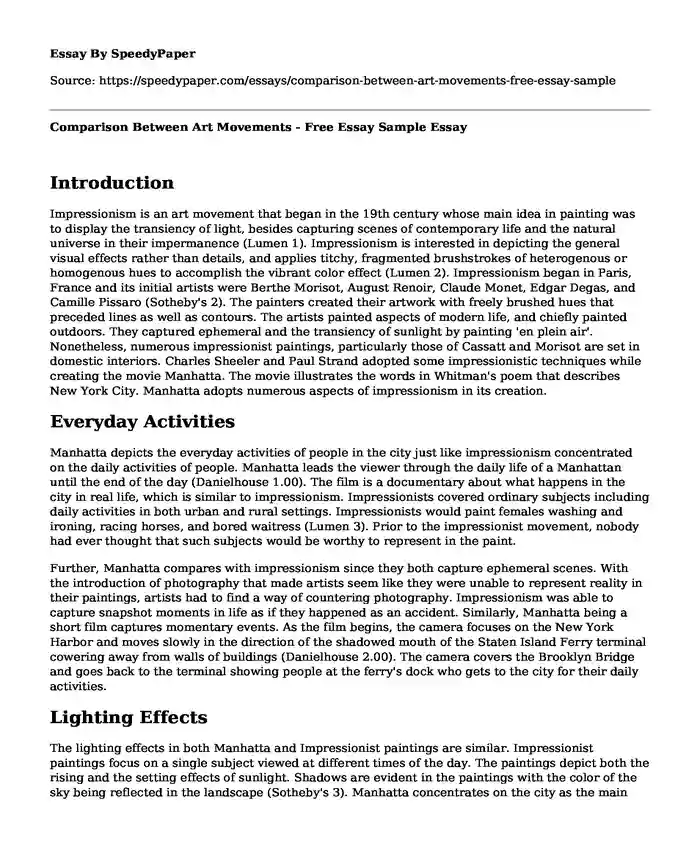Introduction
Impressionism is an art movement that began in the 19th century whose main idea in painting was to display the transiency of light, besides capturing scenes of contemporary life and the natural universe in their impermanence (Lumen 1). Impressionism is interested in depicting the general visual effects rather than details, and applies titchy, fragmented brushstrokes of heterogenous or homogenous hues to accomplish the vibrant color effect (Lumen 2). Impressionism began in Paris, France and its initial artists were Berthe Morisot, August Renoir, Claude Monet, Edgar Degas, and Camille Pissaro (Sotheby's 2). The painters created their artwork with freely brushed hues that preceded lines as well as contours. The artists painted aspects of modern life, and chiefly painted outdoors. They captured ephemeral and the transiency of sunlight by painting 'en plein air'. Nonetheless, numerous impressionist paintings, particularly those of Cassatt and Morisot are set in domestic interiors. Charles Sheeler and Paul Strand adopted some impressionistic techniques while creating the movie Manhatta. The movie illustrates the words in Whitman's poem that describes New York City. Manhatta adopts numerous aspects of impressionism in its creation.
Everyday Activities
Manhatta depicts the everyday activities of people in the city just like impressionism concentrated on the daily activities of people. Manhatta leads the viewer through the daily life of a Manhattan until the end of the day (Danielhouse 1.00). The film is a documentary about what happens in the city in real life, which is similar to impressionism. Impressionists covered ordinary subjects including daily activities in both urban and rural settings. Impressionists would paint females washing and ironing, racing horses, and bored waitress (Lumen 3). Prior to the impressionist movement, nobody had ever thought that such subjects would be worthy to represent in the paint.
Further, Manhatta compares with impressionism since they both capture ephemeral scenes. With the introduction of photography that made artists seem like they were unable to represent reality in their paintings, artists had to find a way of countering photography. Impressionism was able to capture snapshot moments in life as if they happened as an accident. Similarly, Manhatta being a short film captures momentary events. As the film begins, the camera focuses on the New York Harbor and moves slowly in the direction of the shadowed mouth of the Staten Island Ferry terminal cowering away from walls of buildings (Danielhouse 2.00). The camera covers the Brooklyn Bridge and goes back to the terminal showing people at the ferry's dock who gets to the city for their daily activities.
Lighting Effects
The lighting effects in both Manhatta and Impressionist paintings are similar. Impressionist paintings focus on a single subject viewed at different times of the day. The paintings depict both the rising and the setting effects of sunlight. Shadows are evident in the paintings with the color of the sky being reflected in the landscape (Sotheby's 3). Manhatta concentrates on the city as the main subject and represents the city in the morning and in the evening. The film ends in the evening hours, with the camera focused on the sky and the setting of the sun.
Another comparison is that both Impressionist paintings and Manhatta depict outdoor settings. The availability of premixed paints enables artists to paint outdoors. Paintings constructed outdoor displays shadows that are boldly outlined with the blue color of the sky as it reflects surfaces. The majority of the impressionist paintings were created outdoor (Lumen 4). Similarly, Manhatta exhibits the outdoor setting around New York City. The film shows the sky's reflection in the water and the building around the city.
The other comparison of Manhatta and impressionist painting is that they are both fragmented. Impressionism applies broken brush strokes to achieve the effects of the strained color vibration (Lumen, 4). It applies bold brushstrokes of bright hues to depict a quick impression of the importance of the subject. Manhatta is also fragmented in the way it presents its subject. It shows busy streets and footways squat against taller buildings, rooftops, trains, steamships, and other human creations (Danielhouse 5.00). At the beginning of the movie, people walk past a huge wall with rectangular windows.
Conclusion
Impressionist paintings and Manhatta compare in several ways. They both represent the outdoor setting and depict the reflection of the sun. Both the movie and the paintings show fragmented features. They also capture ephemeral events in modern life. The movie Manhatta covers elements of impressionism in moving pictures.
Works Cited
Danielhouse. Manhatta (1921)-Documentary Film by Paul Strand. (2012, March 14).
http://youtu.be/qduvk4zu_hs
Lumen. Impressionism. (2020).
http://courses.lumenlearning.com/boundless-arthistory/chapter/impressionism/
Sotheby's. Impressionism. (2019).
www.sothebys.com/en/art-movements/impressionism.
Cite this page
Comparison Between Art Movements - Free Essay Sample. (2023, Nov 24). Retrieved from https://speedypaper.com/essays/comparison-between-art-movements-free-essay-sample
Request Removal
If you are the original author of this essay and no longer wish to have it published on the SpeedyPaper website, please click below to request its removal:
- Free Essay Sample on Frans-Peter Schubert
- Game of Thrones - Free Essay with a Review of a Television Program
- Essay Example about Media Mandates and Media Regulations
- Essay Sample on Speaker Summary - Alexandra Patsavas
- Digital Age: Revolutionizing Communication & Socialization - Essay Sample
- Paper Example. The Civil Rights Movements History
- Essay Example. Digitalization, New Media and Global Culture: Annotated Bibliography
Popular categories





